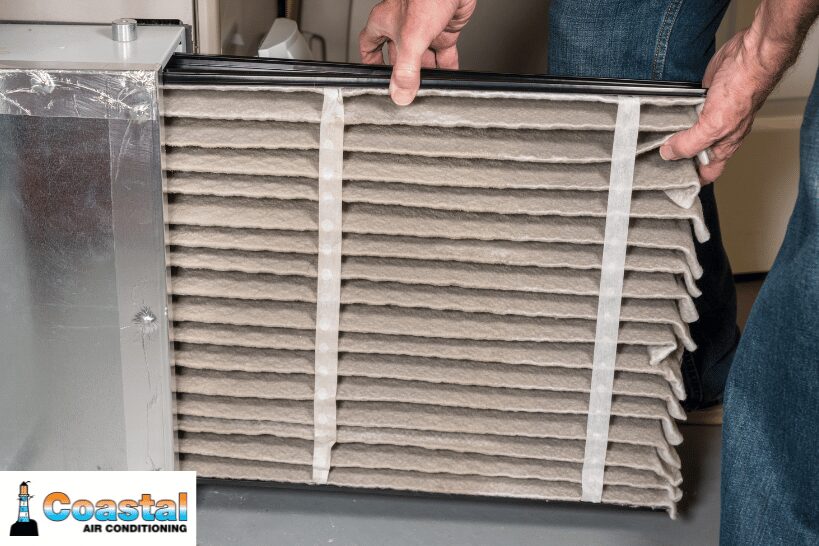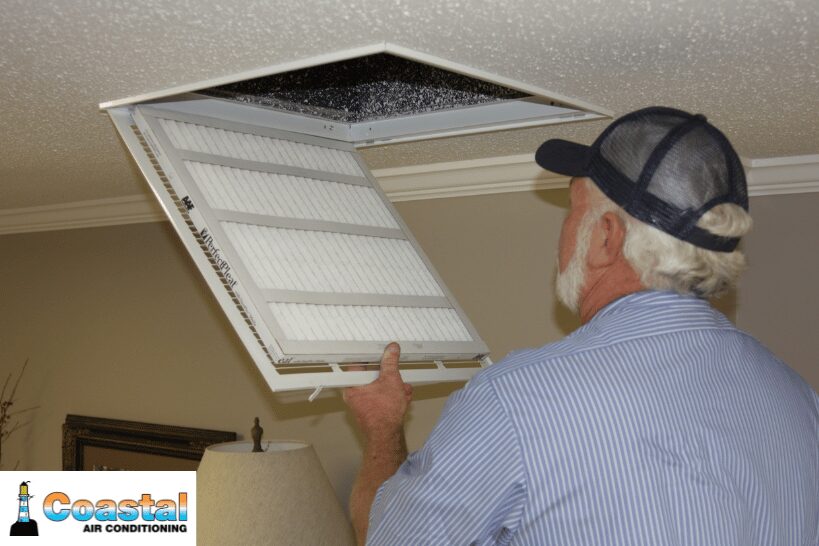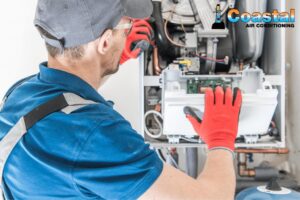If you own a home in New Jersey, your HVAC system works hard year-round. From freezing winters to humid summers, it keeps your home comfortable—and it also plays a big role in your indoor air quality. At the heart of this job is the air filter. It traps dust, dander, pollen, and other airborne particles before they enter your heating and cooling system—or your lungs.
Changing your filter on a regular schedule helps protect your system and the air you breathe, especially during allergy season or when local outdoor pollution is high. This guide explains when and why to change your HVAC filter. It also includes a detailed MERV rating chart to help you pick the right filter for your home in NJ.
Why Your HVAC Filter Matters
Your HVAC filter plays a big part in maintaining airflow and protecting system components. It captures dust, dander, and other contaminants before they reach the blower or ductwork. Without a filter—or with a clogged one—particles collect inside your HVAC system. This can lead to breakdowns and poor airflow.
A clean filter helps your system run more efficiently and improves the quality of the air you breathe at home. This matters if you have allergies, pets, or live near pollution or ongoing construction.

How Often Should You Change Your HVAC Filter?
For most homes, it’s best to change the air filter every 30 to 90 days. But that’s not a one-size-fits-all answer. Many variables decide the right schedule for your household, and the key is understanding what affects your filter’s performance. Below are the main factors that can shorten—or extend—the life of your HVAC filter:
1. Pets (Hair and Dander)
If you have one or more pets in the home, plan to change your air filter more often. Pet hair and dander are major sources of indoor air contaminants. Hair clogs pleats quickly, and dander—tiny flakes of skin—can trigger allergies and asthma. Even if your pet doesn’t shed much, their movement stirs up dust and particles that settle into your HVAC filter.
For one pet, consider changing the filter every 60 days. For multiple pets or allergy-sensitive residents, replace it every 30 days to keep airflow clear and breathing easy.
2. Allergies or Asthma
People with respiratory issues need clean indoor air. Dust mites, pollen, mold spores, and pet dander can aggravate symptoms. A clogged filter won’t remove enough allergens to improve air quality, especially during high-allergy seasons.
In homes with allergy-sensitive residents, swap filters every 30 to 45 days. Use a high-MERV pleated filter for better filtration, but ensure your HVAC system can handle the airflow resistance.
3. Type of Filter
Not all air filters last the same amount of time. Disposable fiberglass filters are cheaper but need replacement monthly. Pleated filters, made of polyester or cotton paper, can trap finer particles and usually last up to 90 days.
High-efficiency filters often have higher MERV ratings and can last longer while removing more contaminants. Still, dust buildup and airflow issues arise over time—so even the most efficient filter needs regular checking.
Here’s a simple guideline:
- Fiberglass: Replace every 30 days
- Pleated (MERV 8 to 12): Replace every 60 to 90 days
- High-efficiency (MERV 13+): Replace every 60 days or as directed
Always refer to the filter label and check its condition once a month.
4. Number of Occupants
A household with more people creates more indoor air pollutants.
Every person sheds skin cells, moves dust, and contributes to humidity. High foot traffic brings in outdoor particles like pollen, dirt, and soot—especially if shoes come off indoors.
If you live alone or with one other person, a 90-day replacement schedule might work fine. In larger households (4+ people), aim for 30- to 60-day changes to maintain indoor air quality and keep your HVAC system from overworking.
5. Indoor Smoking
Tobacco smoke carries fine particles that settle deep into filters—and lungs. It also leaves behind sticky residue on components and increases particle concentration in the air.
If someone smokes inside your home, changing the air filter every 30 days is a good practice to trap more of those contaminants and reduce lingering odors.
Keep in mind: smoke particles are smaller than dust or pollen and require filters with a higher MERV rating to remove effectively.
6. Local Air Quality and Environmental Factors
Your neighborhood’s air also plays a role. Construction sites, wildfires, pollution, or even agricultural activity can push small particles into your home through leaks and ventilation.
If you live in a city with heavy traffic or near a dusty road, you’re likely breathing in more fine particles. Indoor air can also be affected by seasonal changes like pollen spikes in spring or leaf mold in fall. These all contribute to poor indoor air conditions.
Check your filter once a month if you live in areas with bad outdoor air quality. Use a higher-MERV pleated filter that balances filtration and airflow.
7. Your HVAC Usage Patterns
Homes in colder climates may run their heating systems for months at a time in winter. In warmer climates, the air conditioner might work nearly year-round. The more often your HVAC runs, the more air it pulls through your system—and the faster dust and debris load up your filter.
If you run heating or cooling daily for long stretches, err on the side of changing your filter more often than the general 90-day schedule suggests.
Related Article: 10 Signs Your Air Conditioner is About to Fail
Understanding MERV Ratings (What They Mean for Air Quality)
MERV stands for Minimum Efficiency Reporting Value. It’s a 1–20 scale that tells you how well a filter captures airborne particles. The higher the MERV, the smaller the particles it can trap.
Here’s how it works:
- MERV 1–4 filters catch larger particles like pollen or lint
- MERV 5–8 handle mold spores, pet dander, and dust
- MERV 9–12 target finer particles like auto emissions
- MERV 13–16 offer near-hospital-grade filtration
Note: Higher MERV can reduce airflow if your system isn’t designed for it. Always check your HVAC system’s specs before upgrading to a higher rating.
MERV Chart: Compare Ratings and Recommended Usage
| MERV Rating | Captures Particle Size (Microns) | Efficiency by Particle Range | Best For |
| 1–4 | 3.0 – 10.0 | Less than 20% at this range | Basic residential use; captures large particles like dust, carpet fibers, and pollen |
| 5 | 3.0 – 10.0 | ≥ 20% | Homes without pets or allergies; filters larger airborne dust and lint |
| 6 | 3.0 – 10.0 | ≥ 35% | Captures general dust, mold spores, and household debris |
| 7 | 3.0 – 10.0 | ≥ 50% | Useful for homes with light allergy concerns; blocks larger dander particles |
| 8 | 1.0 – 3.0, 3.0 – 10.0 | ≥ 20% (1.0–3.0), ≥ 70% (3.0–10.0) | Good for homes with pets; captures dander, mold spores, and some fine dust |
| 9 | 1.0 – 3.0, 3.0 – 10.0 | ≥ 35% (1.0–3.0), ≥ 75% (3.0–10.0) | Moderate allergy protection; blocks finer dust and pollen |
| 10 | 1.0 – 3.0, 3.0 – 10.0 | ≥ 50% (1.0–3.0), ≥ 80% (3.0–10.0) | Helps reduce indoor allergens and airborne chemicals |
| 11 | 0.3 – 1.0, 1.0 – 3.0, 3.0 – 10.0 | ≥ 20% (0.3–1.0), ≥ 65% (1.0–3.0), ≥ 85% (3.0–10.0) | High-capacity homes with asthma or sensitive occupants |
| 12 | 0.3 – 1.0, 1.0 – 3.0, 3.0 – 10.0 | ≥ 35% (0.3–1.0), ≥ 80% (1.0–3.0), ≥ 90% (3.0–10.0) | Improved indoor air quality; targets allergens and fine particulate pollution |
| 13 | 0.3 – 1.0, 1.0 – 3.0, 3.0 – 10.0 | ≥ 50% (0.3–1.0), ≥ 85% (1.0–3.0), ≥ 90% (3.0–10.0) | Homes near busy roads or wildfire areas; captures smoke, pathogens |
| 14 | 0.3 – 1.0, 1.0 – 3.0, 3.0 – 10.0 | ≥ 75% (0.3–1.0), ≥ 90% (1.0–3.0), ≥ 95% (3.0–10.0) | Advanced filtration; helps reduce bacteria, mold, and fine allergens |
| 15 | 0.3 – 1.0, 1.0 – 3.0, 3.0 – 10.0 | ≥ 85% (0.3–1.0), ≥ 90% (1.0–3.0), ≥ 95% (3.0–10.0) | Suitable for high-sensitivity homes and medical-grade air cleaning |
| 16 | 0.3 – 1.0, 1.0 – 3.0, 3.0 – 10.0 | ≥ 95% across all ranges | Near-HEPA filtration level; reduces airborne bacteria and fine smoke particles |
Note on HEPA and Beyond: While MERV 17–20 ratings are used in cleanrooms and hospital settings, standard residential HVAC systems aren’t designed to handle these. They restrict airflow and can strain the system. If you want HEPA-like performance at home, speak with a technician about standalone air purifiers or customized upgrades.
Signs It’s Time to Replace Your Filter
Sometimes, time isn’t the only indicator. Watch for these signs that your filter needs replacing.
- Your vents blow noticeably less air
- Dust collects quickly on furniture
- Allergy symptoms worsen indoors
- The filter is discolored or clogged when you check it
- Energy bills rise as your HVAC works harder

How to Check and Replace Your Filter
Turn off your HVAC system before removing the old filter. Locate the filter near the blower compartment, return air grille, or air handler. Slide the old one out. If it looks dark gray or clogged, it’s time for a new one.
Insert the new filter in the same direction, following the arrows on the frame for airflow. Turn the system back on when finished.
When to Call a Pro
While replacing your HVAC filter is a simple task, there are times when it’s best to bring in a licensed technician. If you’ve replaced your filter but still notice weak airflow, rising energy bills, or increased dust around your home, there could be a deeper issue within your system. This includes things like ductwork problems, blocked condensate lines, or a failing blower motor.
It’s also a good idea to have your HVAC system inspected if:
- You’re unsure which filter type works best with your system
- You’ve upgraded to a high-MERV filter and notice performance issues
- There are persistent odors or allergy symptoms despite filter changes
- Your system is running louder than usual
If you live in New Jersey and need expert help, Coastal Air Conditioning is here to help. Our HVAC technicians can inspect your system, recommend the best filter for your home, and ensure your heating and cooling equipment runs efficiently—season after season.
Keep Your System Running Clean
Clean air isn’t optional—especially in a state like New Jersey, where changes in weather and regional air quality can challenge even well-maintained HVAC systems. Swapping out your air filter regularly helps keep your system efficient and reduces indoor pollutants like dust, mold spores, and pet dander.
Need help choosing the right filter?
Contact us to schedule service and talk with a technician who knows your system.




